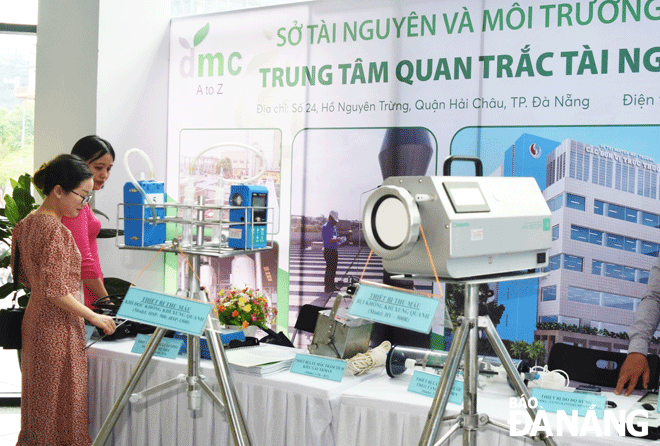Da Nang on track to turn itself into smart city
Building a smart city is a trend that many Vietnamese provinces and cities are aiming for. With continuous efforts, over the past time, Da Nang has deployed tasks of building an e-government and a smart city based on three axes: infrastructure - data - intelligence. In each phase, the deployment of axes is carried out according to different roadmaps and priorities with the criteria ‘One Platform - One Infrastructure - One Policy - Multiple Partners - Multiple Applications’.
 |
| The Centre for Natural Resources and Environment Monitoring (DONRE) introduces monitoring tools at Trung Vuong Theater within the framework of the programme to announce the ‘Building Da Nang into Environmentally-friendly city’ project during the 2021 - 2030 period for the application of environmental monitoring of water, air, and soil. Photo: HOANG HIEP |
Well-invested infrastructure
According to Deputy Director of the Department of Information and Communications Tran Ngoc Thach, building a smart city has become an inevitable trend, a fundamental driving force for the socio-economic development of countries and regions, helping the city solve problems arising in the process of urbanisation. Da Nang has built methodical infrastructure, including public telecommunications infrastructure connecting to the high-speed network, the completed coverage of 3G and 4G, the fixed broadband internet, terrestrial digital television and the pilot deployment of 5G network.
The city also invested in building a telecommunications network exclusively for State agencies, a public wifi system with 430 dedicated transceiver stations connecting to agencies, tourist attractions and public areas, more than 1,000 stations of enterprises, the effective implementation of e-Government platforms (Da Nang eGov system) with many common applications for all national government agencies.
Also, the Mini IOC smart city service monitoring centre and specialized monitoring and oerating centers (smart traffic, smart environment, security and order) was deployed whilst most of the smart city platform components (like Smart City Platform) according to the guiding model of the Ministry of Information and Communications were put into use.
The above-mentioned systems have been developed from specialised and foundational databases, integrated and share data used among central ministries and agencies through the Integration Axis, sharing data into City, forming a shared data warehouse (khodulieu.danang.gov.vn) and providing open data for people and businesses (opendata.danang.gov.vn).
Since its inception in 2017 in the context of the rapid progress of social media channels, the Da Nang Public Service Portal- issued mobile application called ‘Gop Y Da Nang’ (Giving Complaints to Da Nang) for getting feedback on local services from the local community has proved highly effective.
Meanwhile, officially put into use in April 2016, the city’s Public Service Portal with its hotline 0236 1022 has operated effectively, and it has won the trust and high praise from both local residents and visitors. The hotline aims to offer an opportunity for locals and visitors to have their questions and present complaints relating to social security, traffic safety, environmental pollution, and other matters of deep concern in the city.
For two consecutive years, Da Nang was honoured with the Viet Nam Smart City Award organised by the Viet Nam Association for Software and IT Services (VINASA).
Da Nang is now remaining resilient on its strong feet to realise is ambition of becoming the first in Viet Nam to join the ASEAN Smart Cities Network (ASCN) by 2030 under the Resolution No. 43-NQ/TW dated January 24, 2019 adopted by the Politburo on building and developing Da Nang by 2030, with a vision towards 2045,
Enhancing effective applications in practice
The application of information technology and software to serve the job has been widely deployed by units and businesses across the city. Many of them have been obtained great solutions and initiatives, for instance the ‘Intelligent power supply for Da Nang’ developed by the Da Nang Electricity One Member Limited Liability Company. The solution contributes to improving the quality and reliability of power supplies to the city and bringing many convenient services to customers.
In a similar vein, departments and agencies also promoted technological applications in professional work and administration. The city has also been interested in developing many smart applications for medical examinations and treatment.
In light of a prolonged COVID-19, the exchange of information and professional consultations with facilities and leading experts at major hospitals across the country have gone virtual, instead of face-to-face ones.
Since 2018, 100% of commune and ward medical stations, 100% of district health centres and specialized hospitals in Da Nang have deployed smart hospital applications from level 4 or higher according to regulations of the Ministry of Health.
Noticeably, the city has deployed many systems and utilities to serve medical examination and treatment for people such as remote examination and consultation system such as Telehaalth, Doctor 4U and VOV Bacsi24.
In face of COVID-19, Da Nang has promptly deployed many applications for early detection, quick and accurate tracing, and thus contributing to pandemic containment.
According to Deputy Director of the Department of Natural Resources and Environment Vo Nguyen Chuong, thanks to the application of technologies, the agency has achieved positive results in professional work.
Reportedly, in 2021, the city also issued the ‘Plan to build Da Nang into a smart city by 2025, with a vision towards 2030’, with a focus on improving infrastructure, platforms, and data, in tandem with expanding the development of smart applications to serve the management, socio-economic work according to the roadmap.
Reporting by THU HA – Reporting by A.THU